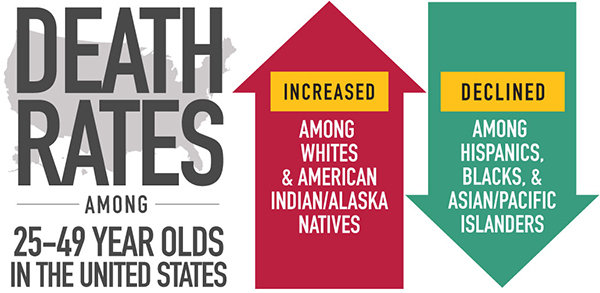
Study finds premature death rates diverge in the United States by race and ethnicity
- Posted: January 25, 2017
Contact:
Premature death rates have declined in the United States among Hispanics, blacks, and Asian/Pacific Islanders (APIs)—in line with trends in Canada and the United Kingdom—but increased among whites and American Indian/Alaska Natives (AI/ANs), according to a comprehensive study of premature death rates for the entire U.S. population from 1999 to 2014. This divergence was reported by researchers at the National Cancer Institute (NCI), and colleagues at the National Institute on Drug Abuse (NIDA), both part of the National Institutes of Health, and the University of New Mexico College of Nursing. The findings appeared January 25, 2017, in The Lancet.
Declining rates of premature death (i.e., deaths among 25- to 64-year-olds) among Hispanics, blacks, and APIs were due mainly to fewer deaths from cancer, heart disease, and HIV over the time period of the study. The decline reflects successes in public health efforts to reduce tobacco use and medical advances to improve diagnosis and treatment. Whites also experienced fewer premature deaths from cancer and, for most ages, fewer deaths from heart disease over the study period. Despite these substantial improvements, overall premature death rates still remained higher for black men and women than for whites.
In contrast, overall premature death rates for whites and AI/ANs were driven up by dramatic increases in deaths from accidents (primarily drug overdoses), as well as suicide and liver disease. Among 25- to 30-year-old whites and AI/ANs, the investigators observed increases in death rates as high as 2 percent to 5 percent per year, comparable to those increases observed at the height of the U.S. AIDS epidemic.
“The results of our study suggest that, in addition to continued efforts against cancer, heart disease, and HIV, there is an urgent need for aggressive actions targeting emerging causes of death, namely drug overdoses, suicide, and liver disease,” said Meredith Shiels, Ph.D., M.H.S., Division of Cancer Epidemiology and Genetics (DCEG), NCI, and lead author of the study.
“Death at any age is devastating for those left behind, but premature death is especially so, in particular for children and parents,” emphasized Amy Berrington, D.Phil., also of DCEG and senior author of the study. “We focused on premature deaths because, as Sir Richard Doll, the eminent epidemiologist and my mentor, observed: ‘Death in old age is inevitable, but death before old age is not.’ Our study can be used to target prevention and surveillance efforts to help those groups in greatest need.”
The study findings were based on death certificate data collected by the National Center for Health Statistics, part of the Centers for Disease Control and Prevention.
About the National Cancer Institute (NCI): NCI leads the National Cancer Program and the NIH’s efforts to dramatically reduce the prevalence of cancer and improve the lives of cancer patients and their families, through research into prevention and cancer biology, the development of new interventions, and the training and mentoring of new researchers. For more information about cancer, please visit the NCI website at cancer.gov or call NCI's Cancer Information Service at 1-800-4-CANCER.
About the National Institutes of Health (NIH): NIH, the nation's medical research agency, includes 27 Institutes and Centers and is a component of the U.S. Department of Health and Human Services. NIH is the primary federal agency conducting and supporting basic, clinical, and translational medical research, and is investigating the causes, treatments, and cures for both common and rare diseases. For more information about NIH and its programs, visit nih.gov.
























.png)











No hay comentarios:
Publicar un comentario